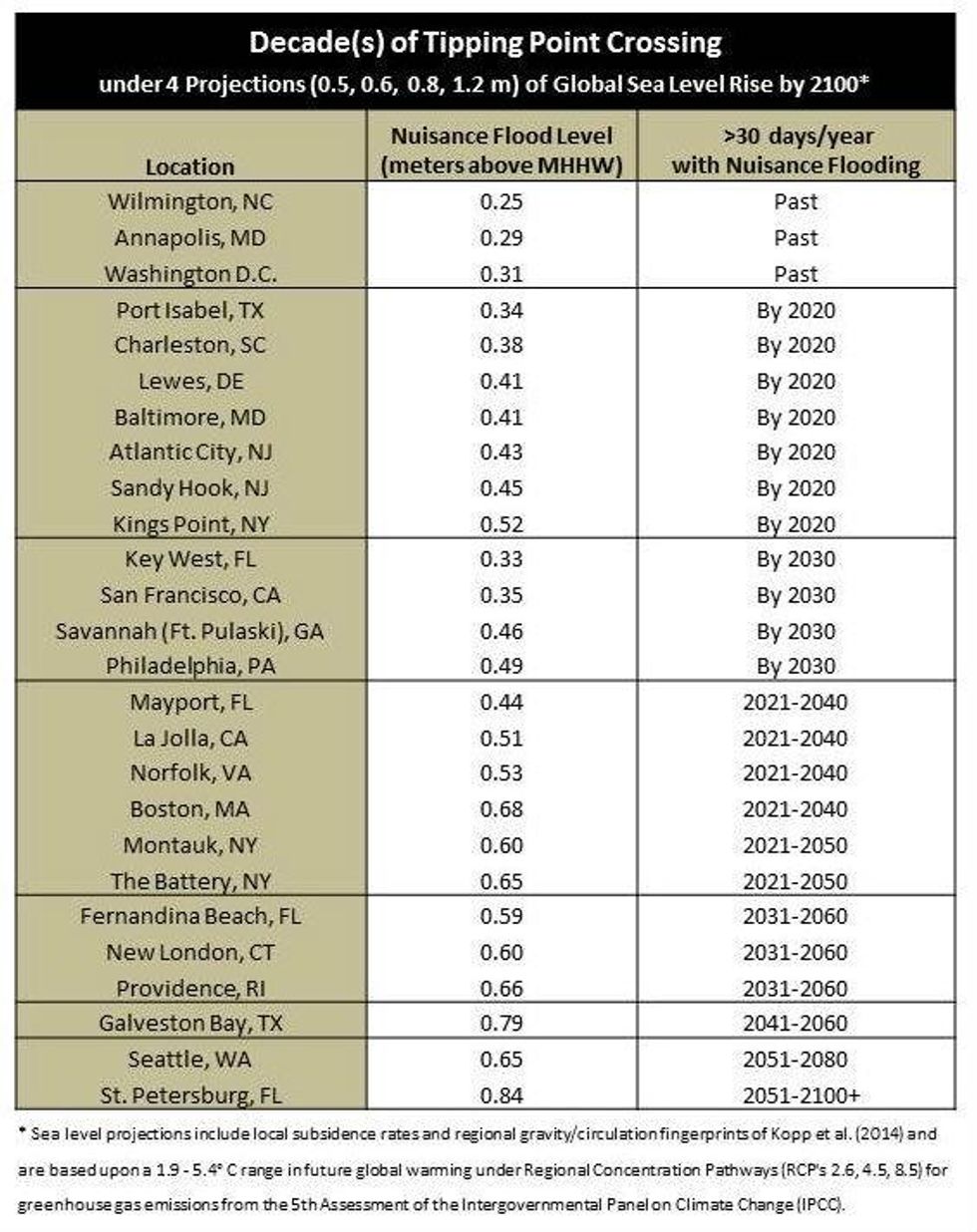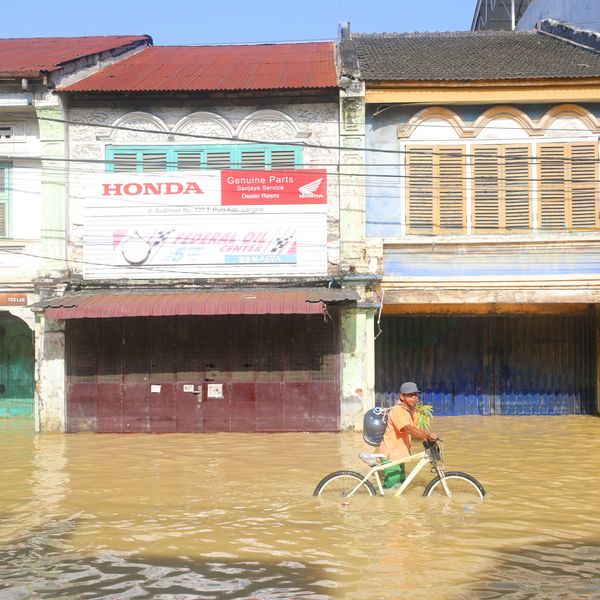Driven by Climate Change, 'Nuisance' Flooding to Become Commonplace in US Coastal Areas
NOAA projects that Boston; New York City; Philadelphia; Baltimore; Washington, D.C.; and other metropolitan areas will be forced to mitigate these nuisance floods earlier than planned
By 2050, a majority of U.S. coastal areas--including urban centers such as Baltimore, Philadelphia, San Francisco, and Boston--will likely be threatened by 30 or more days of flooding each year due to dramatically accelerating sea level rise, according to a new study by the National Oceanic and Atmospheric Administration (NOAA).
The paper, "From the Extreme to the Mean: Acceleration and Tipping Points for Coastal Inundation due to Sea Level Rise," was published Thursday in the American Geophysical Union's online peer-reviewed journal Earth's Future.
Taking into account recent projections for global sea level rise as well as local factors such as frequency of storms and the settling or sinking of land, the NOAA scientists found that 'nuisance flooding'--defined by NOAA's National Weather Service as flooding between one to two feet above local high tide--will cross a tipping point over the next several decades.
"Coastal communities are beginning to experience sunny-day nuisance or urban flooding, much more so than in decades past," said NOAA oceanographer William Sweet, who co-authored the paper. "This is due to sea level rise. Unfortunately, once impacts are noticed, they will become commonplace rather quickly. We find that in 30 to 40 years, even modest projections of global sea level rise--1 1/2 feet by the year 2100--will increase instances of daily high tide flooding to a point requiring an active, and potentially costly response, and by the end of this century, our projections show that there will be near-daily nuisance flooding in most of the locations that we reviewed."
The NOAA team projects that Boston; New York City; Philadelphia; Baltimore; Washington, D.C.; Norfolk, Virginia; and Wilmington, North Carolina will soon make, or are already being forced to make, decisions on how to mitigate these nuisance floods earlier than planned. In the Gulf, NOAA forecasts earlier-than-anticipated floods for Galveston Bay and Port Isabel, Texas. Along the Pacific coast, earlier impacts will be most visible in the San Diego and San Francisco Bay areas.

Mitigation measures could range from retreating further inland to coastal fortification to implementation of infrastructure such as sea walls and redesigned storm water systems.
Although the 'nuisance' classification doesn't impart much urgency, Earth's Future editor Michael Ellis points out: "The paper also raises the interesting question of what frequency of 'nuisance' corresponds to a perception of 'this is no longer a nuisance but a serious hazard due to its rapidly growing and cumulative impacts'."
An Urgent Message From Our Co-Founder
Dear Common Dreams reader, The U.S. is on a fast track to authoritarianism like nothing I've ever seen. Meanwhile, corporate news outlets are utterly capitulating to Trump, twisting their coverage to avoid drawing his ire while lining up to stuff cash in his pockets. That's why I believe that Common Dreams is doing the best and most consequential reporting that we've ever done. Our small but mighty team is a progressive reporting powerhouse, covering the news every day that the corporate media never will. Our mission has always been simple: To inform. To inspire. And to ignite change for the common good. Now here's the key piece that I want all our readers to understand: None of this would be possible without your financial support. That's not just some fundraising cliche. It's the absolute and literal truth. We don't accept corporate advertising and never will. We don't have a paywall because we don't think people should be blocked from critical news based on their ability to pay. Everything we do is funded by the donations of readers like you. Will you donate now to help power the nonprofit, independent reporting of Common Dreams? Thank you for being a vital member of our community. Together, we can keep independent journalism alive when it’s needed most. - Craig Brown, Co-founder |
By 2050, a majority of U.S. coastal areas--including urban centers such as Baltimore, Philadelphia, San Francisco, and Boston--will likely be threatened by 30 or more days of flooding each year due to dramatically accelerating sea level rise, according to a new study by the National Oceanic and Atmospheric Administration (NOAA).
The paper, "From the Extreme to the Mean: Acceleration and Tipping Points for Coastal Inundation due to Sea Level Rise," was published Thursday in the American Geophysical Union's online peer-reviewed journal Earth's Future.
Taking into account recent projections for global sea level rise as well as local factors such as frequency of storms and the settling or sinking of land, the NOAA scientists found that 'nuisance flooding'--defined by NOAA's National Weather Service as flooding between one to two feet above local high tide--will cross a tipping point over the next several decades.
"Coastal communities are beginning to experience sunny-day nuisance or urban flooding, much more so than in decades past," said NOAA oceanographer William Sweet, who co-authored the paper. "This is due to sea level rise. Unfortunately, once impacts are noticed, they will become commonplace rather quickly. We find that in 30 to 40 years, even modest projections of global sea level rise--1 1/2 feet by the year 2100--will increase instances of daily high tide flooding to a point requiring an active, and potentially costly response, and by the end of this century, our projections show that there will be near-daily nuisance flooding in most of the locations that we reviewed."
The NOAA team projects that Boston; New York City; Philadelphia; Baltimore; Washington, D.C.; Norfolk, Virginia; and Wilmington, North Carolina will soon make, or are already being forced to make, decisions on how to mitigate these nuisance floods earlier than planned. In the Gulf, NOAA forecasts earlier-than-anticipated floods for Galveston Bay and Port Isabel, Texas. Along the Pacific coast, earlier impacts will be most visible in the San Diego and San Francisco Bay areas.

Mitigation measures could range from retreating further inland to coastal fortification to implementation of infrastructure such as sea walls and redesigned storm water systems.
Although the 'nuisance' classification doesn't impart much urgency, Earth's Future editor Michael Ellis points out: "The paper also raises the interesting question of what frequency of 'nuisance' corresponds to a perception of 'this is no longer a nuisance but a serious hazard due to its rapidly growing and cumulative impacts'."
By 2050, a majority of U.S. coastal areas--including urban centers such as Baltimore, Philadelphia, San Francisco, and Boston--will likely be threatened by 30 or more days of flooding each year due to dramatically accelerating sea level rise, according to a new study by the National Oceanic and Atmospheric Administration (NOAA).
The paper, "From the Extreme to the Mean: Acceleration and Tipping Points for Coastal Inundation due to Sea Level Rise," was published Thursday in the American Geophysical Union's online peer-reviewed journal Earth's Future.
Taking into account recent projections for global sea level rise as well as local factors such as frequency of storms and the settling or sinking of land, the NOAA scientists found that 'nuisance flooding'--defined by NOAA's National Weather Service as flooding between one to two feet above local high tide--will cross a tipping point over the next several decades.
"Coastal communities are beginning to experience sunny-day nuisance or urban flooding, much more so than in decades past," said NOAA oceanographer William Sweet, who co-authored the paper. "This is due to sea level rise. Unfortunately, once impacts are noticed, they will become commonplace rather quickly. We find that in 30 to 40 years, even modest projections of global sea level rise--1 1/2 feet by the year 2100--will increase instances of daily high tide flooding to a point requiring an active, and potentially costly response, and by the end of this century, our projections show that there will be near-daily nuisance flooding in most of the locations that we reviewed."
The NOAA team projects that Boston; New York City; Philadelphia; Baltimore; Washington, D.C.; Norfolk, Virginia; and Wilmington, North Carolina will soon make, or are already being forced to make, decisions on how to mitigate these nuisance floods earlier than planned. In the Gulf, NOAA forecasts earlier-than-anticipated floods for Galveston Bay and Port Isabel, Texas. Along the Pacific coast, earlier impacts will be most visible in the San Diego and San Francisco Bay areas.

Mitigation measures could range from retreating further inland to coastal fortification to implementation of infrastructure such as sea walls and redesigned storm water systems.
Although the 'nuisance' classification doesn't impart much urgency, Earth's Future editor Michael Ellis points out: "The paper also raises the interesting question of what frequency of 'nuisance' corresponds to a perception of 'this is no longer a nuisance but a serious hazard due to its rapidly growing and cumulative impacts'."

